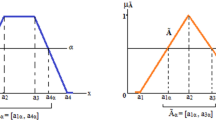Abstract
Existing ubiquitous manufacturing (UM) systems usually plan production and logistics simultaneously to enhance efficiency. A UM system can be further benefited by pursuing economical fabrication, improving product quality, and enhancing partner relationships, which involves possibly conflicting goals, but has rarely been investigated. To address this, an evolving fuzzy approach is proposed in this study by hybridizing diversifying fuzzy analytic hierarchy process (DFAHP), genetic algorithm (GA), and fuzzy technique for order preference by similarity to the ideal solution (FTOPSIS). The evolving fuzzy approach has been applied to a UM system. The superiority of the evolving fuzzy approach over existing methods in meeting various goals was successfully demonstrated by the experimental results.










Similar content being viewed by others
References
Chen T, Tsai HR (2017) Ubiquitous manufacturing: current practices, challenges, and opportunities. Robot Comput Integr Manuf 45:126–132
Ghomi EJ, Rahmani AM, Qader NN (2019) Cloud manufacturing: challenges, recent advances, open research issues, and future trends. Int J Adv Manuf Technol 102(9–12):3613–3639
Putnik G (2012) Advanced manufacturing systems and enterprises: cloud and ubiquitous manufacturing and an architecture. Journal of Applied Engineering Science 10(3):127–134
Tao F, Cheng Y, Da Xu L, Zhang L, Li BH (2014) CCIoT-CMfg: cloud computing and internet of things-based cloud manufacturing service system. IEEE Transactions on Industrial Informatics 10(2):1435–1442
Tao F, Zhang L, Liu Y, Cheng Y, Wang L, Xu X (2015) Manufacturing service management in cloud manufacturing: overview and future research directions. J Manuf Sci Eng 137(4):040912
Zhang Z, Zhang Y, Lu J, Xu X, Gao F, Xiao G (2018) CMfgIA: a cloud manufacturing application mode for industry alliance. Int J Adv Manuf Technol 98(9–12):2967–2985
Zhang Y, Zhang G, Liu Y, Hu D (2017) Research on services encapsulation and virtualization access model of machine for cloud manufacturing. J Intell Manuf 28(5):1109–1123
Ferreira L, Putnik G, Cunha M, Putnik Z, Castro H, Alves C et al (2013) Cloudlet architecture for dashboard in cloud and ubiquitous manufacturing. Procedia CIRP 12:366–371
Zhong RY, Huang GQ, Lan S, Dai QY, Zhang T, Xu C (2015) A two-level advanced production planning and scheduling model for RFID-enabled ubiquitous manufacturing. Adv Eng Inform 29(4):799–812
Lin YC, Chen T (2017) A ubiquitous manufacturing network system. Robot Comput Integr Manuf 45:157–167
Morgan J, O’Donnell GE (2017) Enabling a ubiquitous and cloud manufacturing foundation with field-level service-oriented architecture. Int J Comput Integr Manuf 30(4–5):442–458
Wang M, Zhang Z, Li K, Zhang Z, Sheng Y, Liu S (2019b) Research on key technologies of fault diagnosis and early warning for high-end equipment based on intelligent manufacturing and Internet of Things. Int J Adv Manuf Technol:1–10
Wang XV, Wang L, Mohammed A, Givehchi M (2017a) Ubiquitous manufacturing system based on cloud: a robotics application. Robot Comput Integr Manuf 45:116–125
Wang YC, Chen T, Lin YC (2019a) A collaborative and ubiquitous system for fabricating dental parts using 3D printing technologies. Healthcare 7(3):103
Fang J, Qu T, Li Z, Xu G, Huang GQ (2013) Agent-based gateway operating system for RFID-enabled ubiquitous manufacturing enterprise. Robot Comput Integr Manuf 29(4):222–231
Hu L, Peng T, Peng C, Tang R (2017) Energy consumption monitoring for the order fulfilment in a ubiquitous manufacturing environment. Int J Adv Manuf Technol 89(9–12):3087–3100
Luo H, Fang J, Huang GQ (2015) Real-time scheduling for hybrid flowshop in ubiquitous manufacturing environment. Comput Ind Eng 84:12–23
Dubey R, Gunasekaran A, Chakrabarty A (2017) Ubiquitous manufacturing: overview, framework and further research directions. Int J Comput Integr Manuf 30(4–5):381–394
Chen T, Lin YC (2017) Feasibility evaluation and optimization of a smart manufacturing system based on 3D printing: a review. Int. J. Intell. Syst. 32(4):394–413
Wang J, Xie J, Zhao R, Zhang L, Duan L (2017b) Multisensory fusion based virtual tool wear sensing for ubiquitous manufacturing. Robot Comput Integr Manuf 45:47–58
Chen TCT, Lin YC (2019) A three-dimensional-printing-based agile and ubiquitous additive manufacturing system.Robot Comput Integr Manuf 55:88–95
Wang X, Ong SK, Nee AYC (2018) A comprehensive survey of ubiquitous manufacturing research. Int J Prod Res 56(1–2):604–628
Wu HC, Chen TCT (2018) Quality control issues in 3D-printing manufacturing: a review. Rapid Prototyp J 24(3):607–614
Ilbahar E, Karaşan A, Cebi S, Kahraman C (2018) A novel approach to risk assessment for occupational health and safety using Pythagorean fuzzy AHP & fuzzy inference system. Saf Sci 103:124–136
Laili Y, Zhang L, Tao F (2011) Energy adaptive immune genetic algorithm for collaborative design task scheduling in cloud manufacturing system. 2011 IEEE International Conference on Industrial Engineering and Engineering Management, pp 1912–1916
Lima Junior FR, Osiro L, Carpinetti LCR (2014) A comparison between fuzzy AHP and fuzzy TOPSIS methods to supplier selection. Appl Soft Comput 21:194–209
Huang D, Chen T, Wang MJJ (2001) A fuzzy set approach for event tree analysis. Fuzzy Sets Syst 118(1):153–165
Zheng G, Zhu N, Tian Z, Chen Y, Sun B (2012) Application of a trapezoidal fuzzy AHP method for work safety evaluation and early warning rating of hot and humid environments. Saf Sci 50(2):228–239
Satty, T. (1980) The Analytical Hierarchy Process. McGraw Hill, New York.
Yager RR, Kacprzyk J (2012) The ordered weighted averaging operators: theory and applications. Springer Science & Business Media
Author information
Authors and Affiliations
Corresponding author
Additional information
Publisher’s note
Springer Nature remains neutral with regard to jurisdictional claims in published maps and institutional affiliations.
Rights and permissions
About this article
Cite this article
Chen, T., Wang, YC. An evolving fuzzy planning mechanism for a ubiquitous manufacturing system. Int J Adv Manuf Technol 108, 2337–2347 (2020). https://doi.org/10.1007/s00170-020-05225-w
Received:
Accepted:
Published:
Issue Date:
DOI: https://doi.org/10.1007/s00170-020-05225-w




